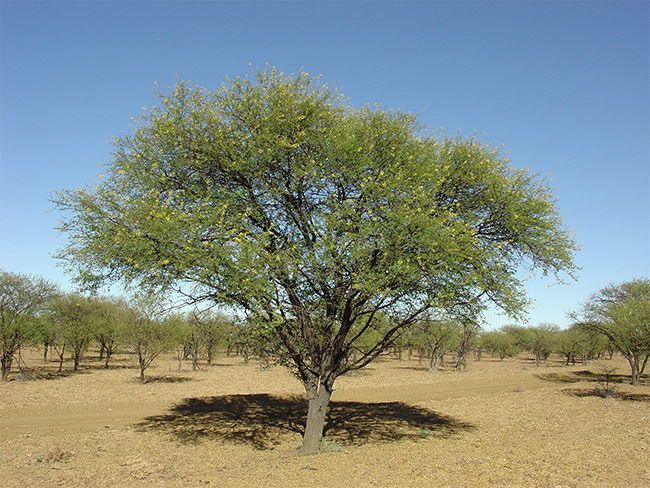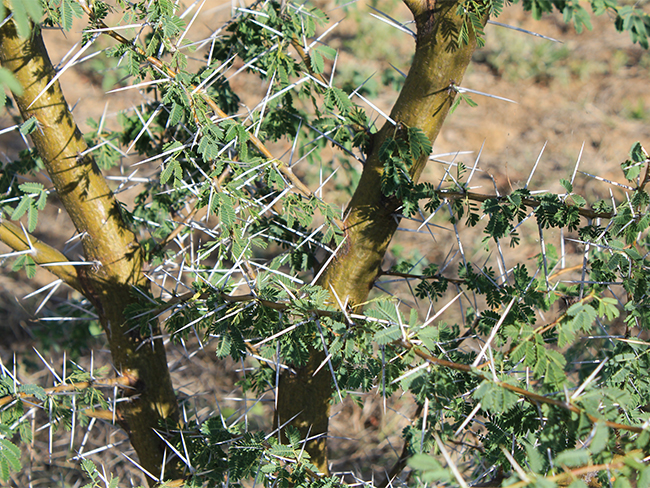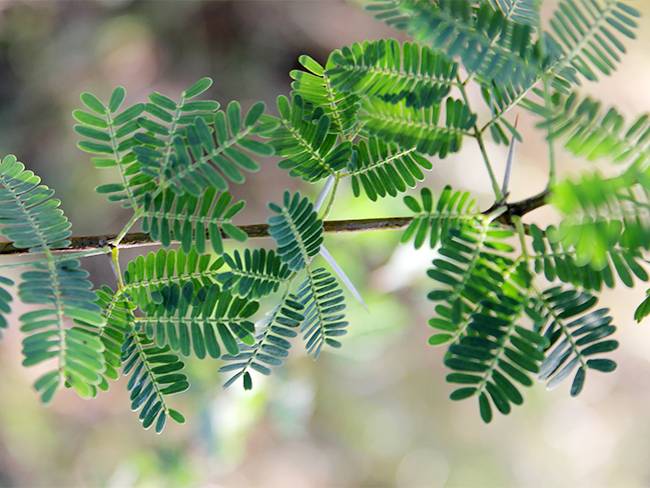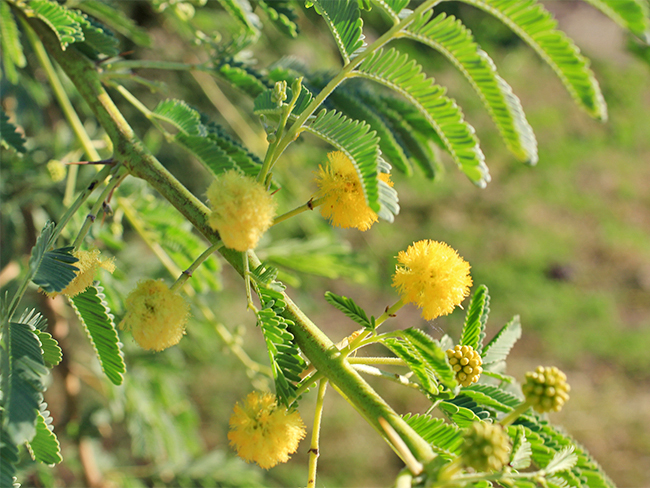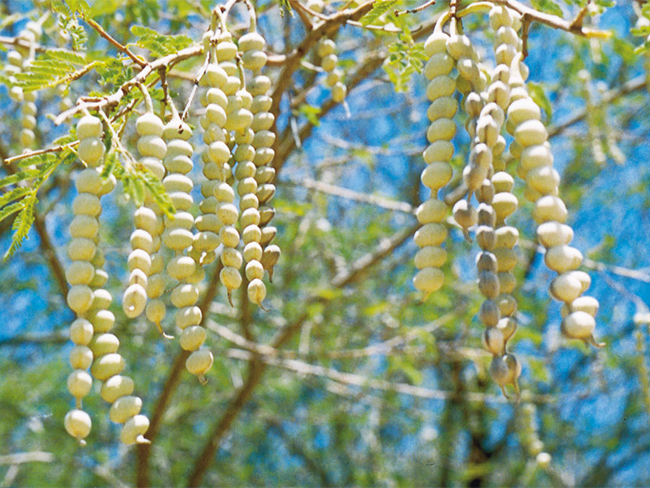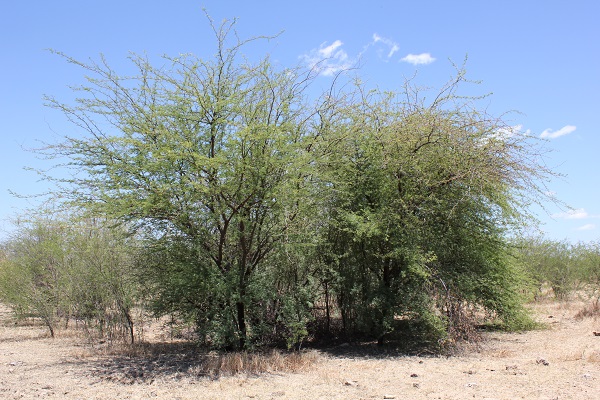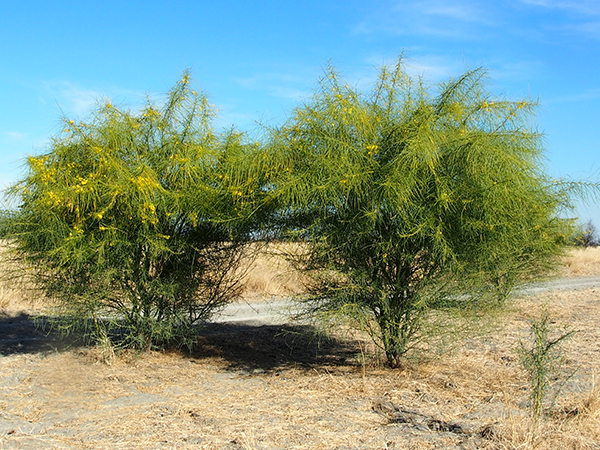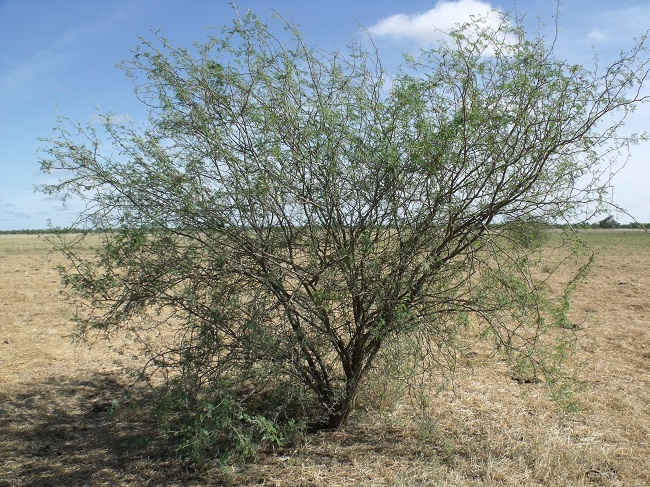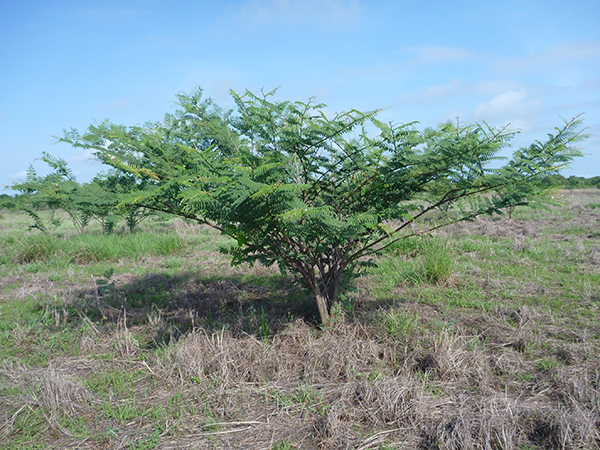Prickly acacia
Scientific name: Acacia nilotica or Vachellia nilotica
Declaration status: Class A
Prickly acacia is a Weed of National Significance. For more information, go to the Australian Government's Department of Agriculture, Water and the Environment website.
Prickly acacia has a revised statutory weed management plan PDF (1.5 MB) which outlines the legal requirements for control.
Read the summary review report on prickly acacia and mesquite PDF (521.1 KB). This report was used to form the current weed management plan.
Research has found that early intervention combined with an ongoing yearly control program will help deliver the best return on investment for the control of prickly acacia.
To find out more, go to the Department of Environment, Parks and Water Security (DEPWS) website.
Prickly acacia is also native to the tropics and subtropics of Africa, Pakistan, India and Myanmar.
It was first imported into Australia as a shade and fodder tree. It now prospers along water courses and out-competes native plants.
It's distributed from the New South Wales border, through Queensland, and across the Northern Territory (NT) to Western Australia's Kimberley region.
It's found in scattered, isolated populations across the NT including the Barkly tablelands and Katherine region, with a substantial infestation in the southern Victoria River region.
Impact
Prickly acacia already infests more than 6.6 million hectares of Australia.
It threatens agriculture and environment across most of northern Australia, including important production areas of the NT such as the Barkly tablelands.
Prickly acacia can have all of the following impacts:
- dense infestations can reduce pasture production
- thickets restrict mustering and restrict stock access to water
- infestations exclude native plants and animals reducing biodiversity
- thorns can damage vehicle tyres and injure animals.
Identification
To identify prickly acacia, you should use this as a guide:
- thorny, umbrella-shaped tree grows up to 10m tall and can form dense thickets
- single stemmed with spreading branches
- paired spines up to 5cm long at base of leaf stems (older stems may not have spines)
- smooth bark with a green and orange tinge (rough brown and black bark on older trees)
- four to 10 branches with 10 to 20 pairs of leaflets on each – leaflets about 6mm long by 1.5mm wide
- golden yellow flowers with spherical heads 1.2cm wide
- borne on multiple stalks 2cm to 4cm long growing out of leaf joints
- 10cm to 20cm long, soft and hairy, grey and green when ripe.
To help you identify a prickle bush that might be prickly acacia, read the what prickle bush is that? guide PDF (85.5 KB).
View a 3D interactive model of this weed below.
© Regional NSW through NSW DPI Invasive Species Biosecurity
Model created by Rachel Klyve
There may also be other plants or weeds that look similar below.
To find out more, get the prickly acacia weed note on the DEPWS website.
If you are unsure, contact the Weed Management Branch.
Similar looking plants
The following plant species look similar to prickly acacia:
Mesquite
Mesquite (Prosopis spp.) is native to North and South America.
Severe mesquite infestations can reduce the production of native and introduced pasture species by up to 90%.
Find out more about mesquite.
Parkinsonia
Parkinsonia (Parkinsonia aculeata) is native to central and South America, Mexico and southern USA.
It infests nearly 1 million hectares and threatens the agriculture and environmental values over three-quarters of the Australian mainland.
Find out more about parkinsonia.
Mimosa bush
Mimosa bush (Acacia farnesiana) is native to Central and South America.
It's a rounded shrub or small tree that forms thorny thickets that hinder mustering and stock access to water.
It's not a declared weed in the NT.
Mimosa
Mimosa (Mimosa pigra) is native to tropical America from Mexico to northern Argentina.
It's estimated that up to 140,000 hectares of land in the NT, 10% of the Territory's wetlands, is already impacted by mimosa.
Find out more about mimosa.
Control
Chemical control
The best time to treat prickly acacia is from March to May.
See list of treatment methods that can be used in the table below.
| Chemical and concentration | Rate | Situation, method and notes |
|---|---|---|
|
Fluroxypyr 200g/L Various trade names | 750ml / 100L |
Seedling (individuals or infestation) and adult (infestation): Foliar spray - Uptake® spraying oil required |
|
Fluroxypyr 333g/L Starane™ Advanced | 450 ml / 100L |
Seedling (individuals or infestation) and adult (infestation): Foliar spray - Uptake® spraying oil required |
|
Metsulfuron-methyl 600g/kg Various trade names | 10g / 100L |
Seedling (individuals or infestation) and adult (infestation): Foliar spray - apply when actively growing, need wetting agent |
|
Hexazinone 250g/L Various trade names |
4ml / spot (One spot for each metre in height) |
Seedling (individuals or infestation) and adult (infestation): Spot application - apply at the base of plant |
|
Tebuthiuron 200g/kg Various trade names | 1.5g / m2 |
Seedling (individuals or infestation) and adult (infestation): Granulated herbicide: ground applied – do not use within 30m of desirable trees or apply to single continuous area > 0.5ha Use higher rate on dense growth or heavy clay soils |
|
Triclopyr 240 g/L + Picloram 120 g/L Access™ | 1L / 60L (diesel) |
Adult (individuals or infestation): Basal bark < 5cm stem diameter Cut stump > 5cm stem diameter |
|
Fluroxypyr 333g/L Starane™ Advanced |
900ml / 100L (diesel) |
Adult (individuals or infestation): Basal bark < 10cm stem diameter, treat up to 45cm from ground Cut stump > 10cm stem diameter |
|
Triclopyr 600g/L Various trade names |
1L / 120L (diesel) 1L / 120L (diesel) |
Adult (individuals or infestation) Basal bark < 5cm stem diameter Cut stump > 5cm stem diameter |
Non-chemical control
For a list of non-chemical treatment methods you can use, read below.
Hand pulling and grubbing
Weeds including their roots are pulled out of the ground by hand or using hand tools. This is an effective method of control for individual weeds and recent outbreaks that haven't released seeds yet.
Blade ploughing
A blade plough is used to push over some woody shrubs and sever their roots underground. This exposes the roots and then buries the plant deep enough that it can't regenerate.
Stick raking
A large blade with teeth attached to a bulldozer is used to clear large weed infestations. This leaves large areas of soil exposed so follow up control or revegetation should be considered.
Chaining
A large heavy chain is dragged across the ground by heavy machinery to push over and pull out large weeds. This method is useful for removing roots and providing access for burning.
It works best at the end of the wet season when the ground is soft and roots are easier to pull from the soil. This method has been successful in prickly acacia control where dense stands are dry or in drought.
Fire
Fire as a management technique is most effective when it's used together with other methods. It's useful for mass seedling control if there is a sufficient fuel load.
Biocontrol
Biological control options have been researched in Queensland including tip boring moths, seed feeding beetles, leaf feeding beetles, caterpillars and bark and wood-feeding insects.
Spread
Prickly acacia seeds are distributed on the hair and hooves of cattle and when they pass intact through a cow's digestive tract.
Seeds are also spread by flowing water.
Prevention
You can prevent the spread of prickly acacia by:
- mapping infestations to help develop a management plan
- controlling minor infestations, isolating outbreaks or seedlings first
- prioritising control along bore drains, creeks and dams to reduce spread
- designating wash down areas and actively working to prevent contamination of clean areas
- fencing off stock from mature pods to contain infestations
- quarantining stock when moving them from an infested area as seeds can take six days to pass through an animal
- not overgrazing as healthy pasture will reduce the growth of seedlings
- making sure imported stock are quarantined upon arrival to the NT or your property
- monitoring areas that you have treated and watch for re-infestations.
Give feedback about this page.
Share this page:
URL copied!
